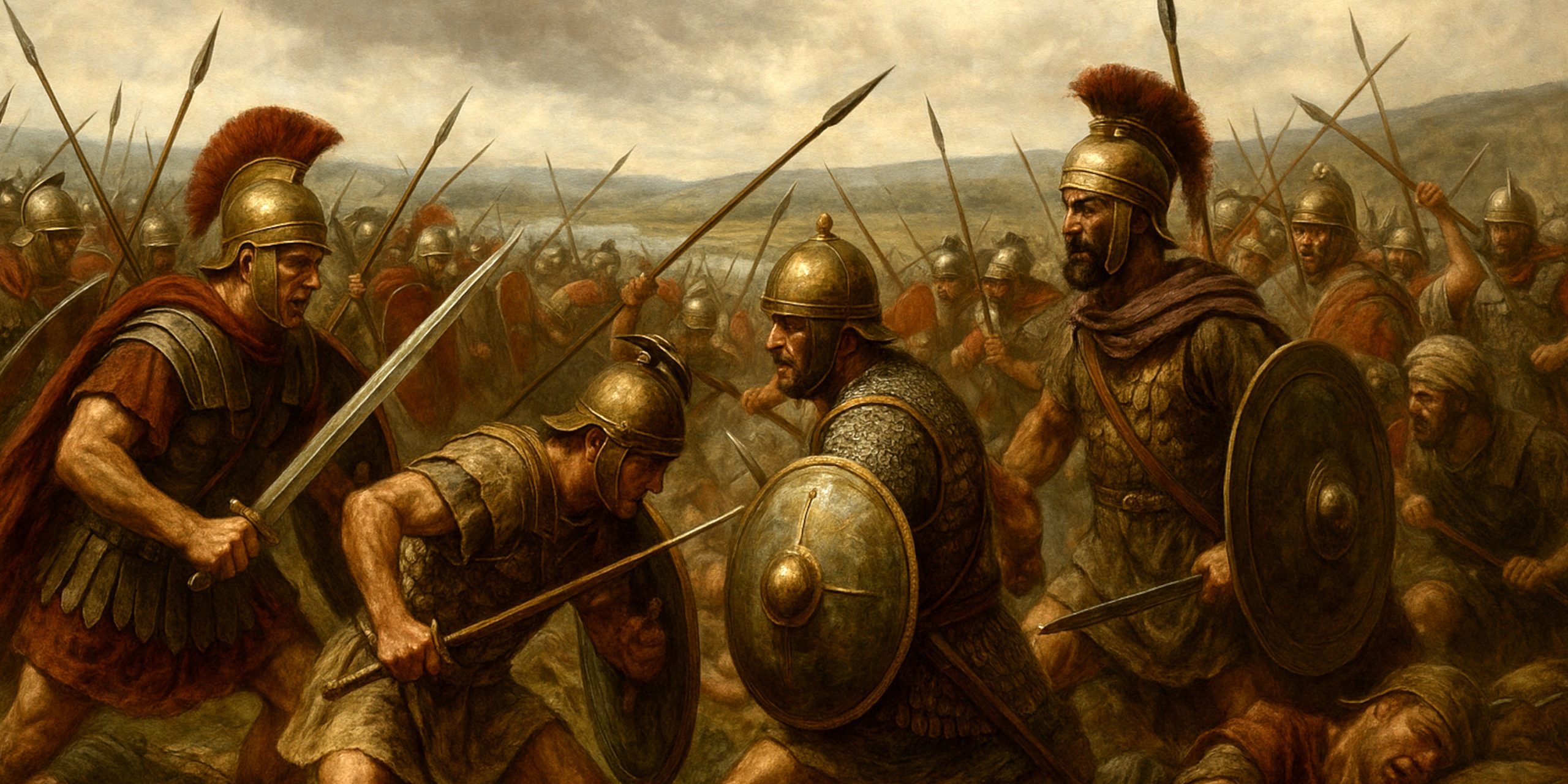
The Battle of the Metaurus was one of the most decisive engagements of the Second Punic War. It ended the Carthaginian threat in northern Italy and destroyed any realistic hope Hannibal had of reinforcements from his brother, Hasdrubal Barca. Fought near the Metaurus River in Umbria, the battle showcased Roman resilience and strategic unity at a critical moment.
Background
In 207 BC, Hasdrubal Barca led a Carthaginian army from Hispania into Italy to join forces with Hannibal in the south. His plan was to combine their armies and deliver a fatal blow to Rome. The Romans, however, intercepted communications between the brothers and acted swiftly to prevent their junction. Two consular armies, under Marcus Livius Salinator and Gaius Claudius Nero, moved to intercept Hasdrubal near the Metaurus.
Forces
| Side | Commander(s) | Estimated Troops |
|---|---|---|
| Roman Republic | Marcus Livius Salinator, Gaius Claudius Nero | 40,000–45,000 |
| Carthaginian | Hasdrubal Barca | 30,000–35,000 |
Leaders and Troop Composition
Roman Commanders:
- Marcus Livius Salinator: Consul of 207 BC, commanding the northern Roman army.
- Gaius Claudius Nero: Consul and commander in the south, who made a rapid and unauthorised march north to reinforce Livius.
Carthaginian Commander:
- Hasdrubal Barca: Brother of Hannibal, seasoned general, responsible for the Carthaginian effort in Hispania before marching into Italy.
Roman Army Composition:
- Heavy infantry (principes and hastati)
- Triarii (veteran reserve spearmen)
- Velites (light skirmishers)
- Allied contingents from central Italy
- Cavalry, including Roman equites and Latin allies
Carthaginian Army Composition:
- Libyan and Iberian heavy infantry
- Ligurian auxiliaries
- Numidian cavalry
- War elephants (though likely minimal in number)
- Gauls recruited en route
Arms and Armour
Roman Soldiers:
- Gladius Hispaniensis: Short stabbing sword
- Scutum: Large curved rectangular shield
- Lorica Hamata: Mail armour
- Galea: Bronze helmet with cheek guards
- Pila: Heavy throwing javelins
Carthaginian Soldiers:
- Iberian falcata or gladius-like swords: Carried by Spanish mercenaries
- Round or oval shields: Varying by region and origin
- Scale or linen armour: Among Libyans and elite troops
- Slingers and archers: Especially from Balearic Islands and North Africa
Battle Timeline

- Night before battle: Hasdrubal, unaware of Nero’s arrival, plans to cross the Metaurus but is delayed due to unfamiliar terrain and lack of guides.
- Early morning: Romans deploy with Livius in the centre and left, Nero taking the right flank.
- Midday: Fierce fighting across the front. Livius struggles against the strongest part of Hasdrubal’s line.
- Afternoon: Nero redirects troops from his quiet right flank to flank Hasdrubal’s left.
- Later afternoon: The Carthaginian line collapses under pressure. Hasdrubal dies in battle, reportedly charging into the Roman ranks rather than flee.
Archaeology
There is no definitive battlefield site agreed upon by modern archaeologists, but several finds in the Marche and Umbria regions have supported theories about the general location. Inscriptions, bronze weapons, and fragments of Roman military equipment have been uncovered in the upper Metauro valley, with some researchers placing the likely site near modern Fossombrone.
Local excavation efforts are limited, and no war elephant remains have been found, suggesting Hasdrubal’s elephants may not have survived the Alpine crossing or were too few to make an impact.
Contemporary Quotes
Livy, Ab Urbe Condita, describes the Roman mood following Nero’s return to southern Italy with Hasdrubal’s severed head:
“When he arrived, he ordered Hasdrubal’s head to be flung before the Carthaginian outposts. A mourning such as no joy could lessen broke out among Hannibal’s ranks.”
On Hasdrubal’s courage, Livy also records:
“Seeing the gods were against him, Hasdrubal spurred his horse into the thickest part of the enemy line, seeking the death he would not avoid.”
Aftermath and Legacy
The Battle of the Metaurus shattered any realistic chance of Carthage winning the war in Italy. It severed Hannibal’s lifeline and permanently removed the threat of reinforcements. Hannibal reportedly said upon learning of the defeat, “I see the doom of Carthage.”
The victory cemented Roman superiority and allowed the Republic to go fully on the offensive. Within a decade, Scipio Africanus would land in Africa and defeat Hannibal at Zama, bringing the Second Punic War to an end.
The Battle of the Metaurus is often cited as one of the most important battles in Roman history, not for its scale, but for the critical blow it dealt to the Carthaginian war effort at a turning point in the conflict.
Watch the documentary:



